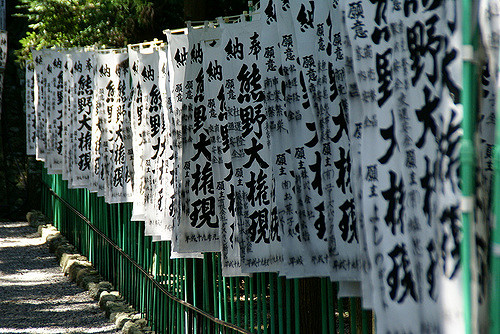
photo by Teppei Shimokawa
Spiritual places are where people go to boost their fortune. They are said to be all over Japan. Many people recall having extraordinary experiences in these spiritual sites. This post introduces you to those spiritual places in Japan selected as World Heritage Sites. World Heritage + Spiritual Site = Double good luck!
Spiritual site in Wakayama Prefecture: Kumano Sanzan
Kumano Sanzan, recognised as a World Heritage site, refers to the sacred shrines and pilgrimage routes in the Kii Mountain Range. The principal destinations, the 3 Grand Shrines of Hongu, Hayatama and Nachi are all separated by a distance of 20~40km. The trails along the Kumano Sanzan are considered the oldest spiritual pilgrimage in Japan. Recognised as well-worth visiting, the region received 3 stars in the Michelin Green Guide of Japan. As well as the Hongu Grand Shrine, the Hayatama Grand Shrine and the Nachi Grand Shrine, there are three other spiritual sites in this area we strongly recommend you visit:
Recommended spot 1: Nachi Waterfall
Since long ago, pilgrims have come to worship this waterfall in the Hiro Shrine, a part of the Grand Shrine of Nachi. The 133 metre drop in height to the bottom of the falls is the longest drop of any waterfall in Japan.
Hiro Shrine,
Mount Nachi, Nachi Katsuura town, Higashimuro district, Wakayama Prefecture.
Recommended spot 2: Gotobiki Rock
Gotobiki rock is the manifestation of the deity at Kamikura Shrine, a part of the Hayatama Grand Shrine. The enormous rock has long been worshipped as the place where a deity descended. A steep climb up 538 stone steps is the only way to reach this rock.
Kamikura Shrine,
Shingu City, 1-13-8, Wakayama Prefecture.
Recommended spot 3: Hana-no-iwaya Shrine
Hana-no-iwaya Shrine is the graveyard of the female deity, Izanami who gave birth to the gods of Japan. In the ancient book, The Chronicles of Japan, this is recognised as the oldest shrine in the country. As a historic sacred site, the shrine attracts many visitors.
Hana-no-iwaya Shrine,
Arima town 130, Kumano city, Mie prefecture.
Spiritual Site in Aomori prefecture and Akita prefecture: Shirakami Mountain Range
This mountain range of around 1,000 metres spreads across Aomori and Akita prefectures. The first World Heritage recognised-site in Japan, in this region you can see some of the biggest beech trees in the world, all growing without any human interference. At the western foot of the Shirakami mountains there are over 30 lakes: the most beautiful of these is the mysterious blue lake. Tens of thousands of visitors come to visit this blue lake, an immensely popular spiritual spot. As the name suggests, the lake is completely blue, but why it is blue, remains a mystery.
Blue Lake,
Fukaura town, West Tsugaru, Aomori Prefecture.
Spiritual Site in Hiroshima Prefecture: Itsukushima Shrine
The building of this extraordinary shrine uses the sea for its foundation. The building provides a rare chance to see up close the beauty of Heian period architecture. Worshipped by the wealthy Taira clan in the Heian period, the shrine was a large scale construction. The red torii gate that stands in the sea is an iconic sight. At high tide, the shrine buildings are all surrounded by water, a surreal sight! The flood of water can damage some of the buildings, but not those buildings that were around when the Taira clan prospered. The main shrine building, which was around in the Taira period, has never been damaged by high tide. This must be a sign of its immense power! Miyajima is also well known for the……… deer!Stunning at first sight, there are so many of them the creatures stop being a feature, and end up just being a normal part of the scenery. Sorry, deer fans!
Itsukushima Shrine,
Miyajima town 1-11, Hatsukaichi, Hiroshima prefecture
Spiritual Site in Okinawa Prefecture: Shuri Castle
Shuri Castle is a classic example of Ryukyu architecture incorporating a mix of Chinese and Japanese styles. This is the largest wooden building in Okinawa prefecture in what was formerly the heart of the Ryukyu kingdom. Considered to have been first constructed in the late 13th century, the building was burnt down during World War Two. The current incarnation was built in 1992. Underground are the remains of the old castle where the soil is said to contain the strongest qi, a powerful life-force in feng shui The inside of the castle building is decorated with many pictures of dragons. Dragons are a symbol of power and considered good fortune.
Shuri Castle,
Shurikinjo Town 1-2, Naha City, Okinawa Prefecture.
Spiritual Site in Kagoshima Prefecture: Yakushima
Finally, the symbol of Japan’s spiritual sites, the island of Yakushima. Many visitors here fall in love with this mysterious, southern island surrounded by beautiful blue ocean. The whole island, often covered in a mysterious mist, is considered a spiritual site. This sugi (cryptomeria) tree is over 4,000 years old. It is so old and famous you will want to shake its hand. It is a real grandfather (or grandma?). Meeting this sugi tree requires an 11km one-way walk along a mountain trail. The return journey takes over 10 hours. You need to be fit and ready for a long hike!
Jomon Sugi,
Miyanoura, Yakushima Town, Kumage district, Kagoshima Prefecture.
Why not take a trip to a spiritual site?!
The rule at spiritual sites is to behave modestly and with respect, as if you are visiting someone else’s home. Also, even if just for a short time, the sites are a good place to relax and reflect on ourselves. Who knows, you might even take away some important answers.
